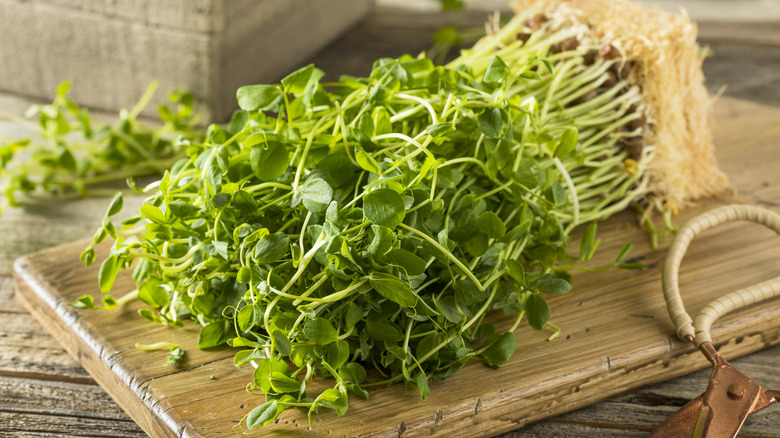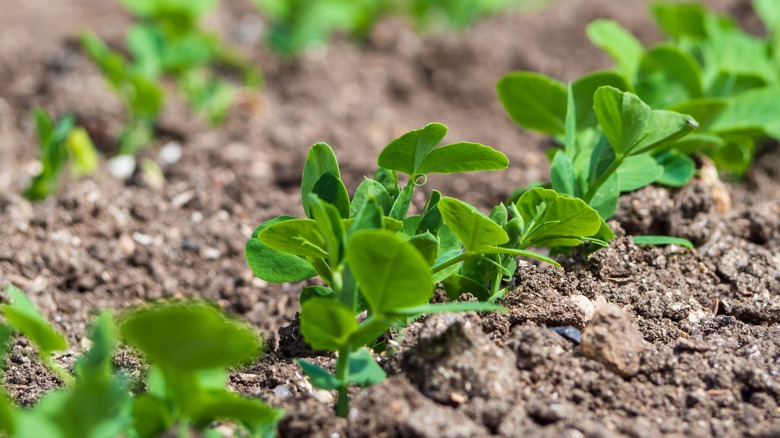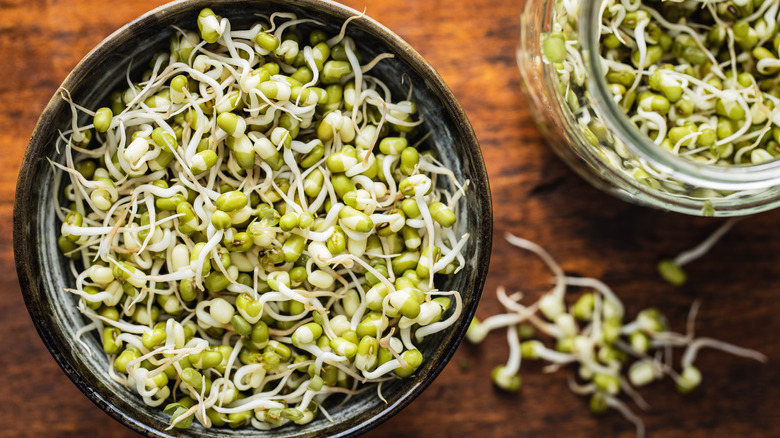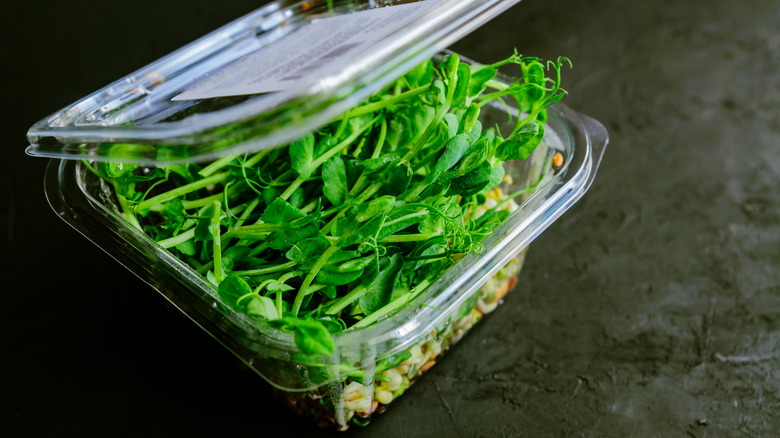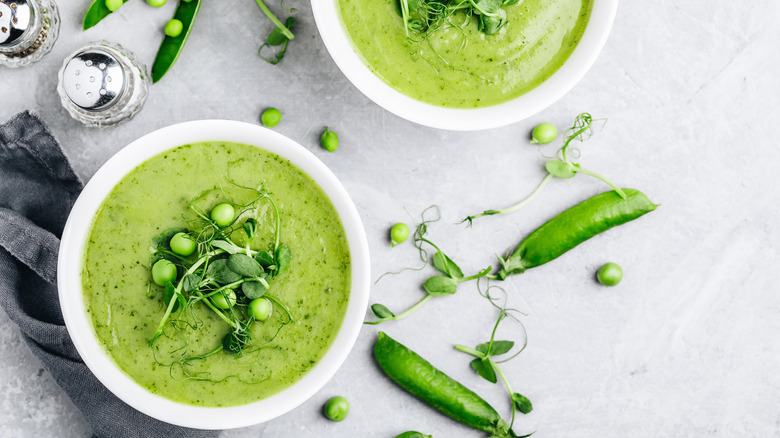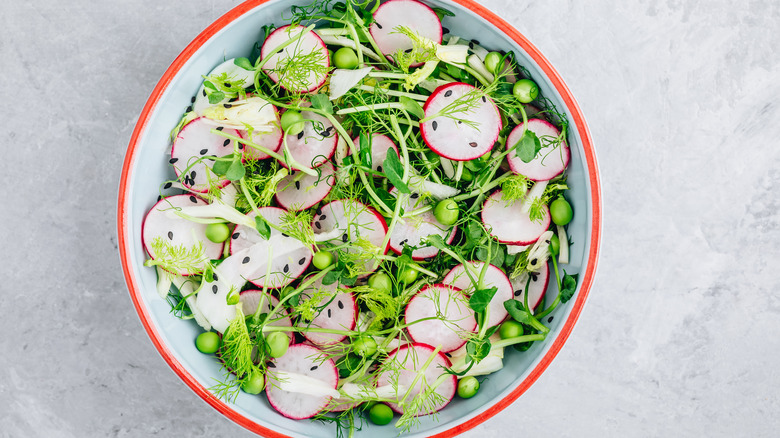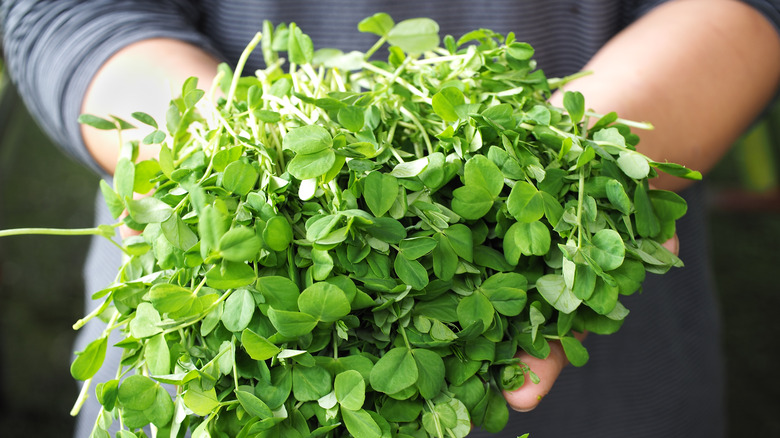What Are Pea Shoots And Can You Eat Them Raw?
Peas may not be your favorite vegetable. In fact, if you grew up eating peas and carrots with dinner, you may even associate them with the less fun half of a meal. But peas are versatile little nuggets — they can be simmered into a mushy pea paste, but they can also be incorporated into recipes for split pea soup, garlic chicken lo mein, pork fried rice, and an array of fresh spring dishes.
But that's not all peas are good for. If you happen to catch pea plants before they turn into full-grown peas, you may be able to get your hands on light, delicate pea shoots. This term encompasses pretty much any other part of the plant beside the seed, or the pea as we know it. Pea shoots can be leaves, stems, and tendrils, and they're usually harvested long before the seeds. That's good news for those of us trying to incorporate fresh vegetables into our springtime meals — not only are pea shoots edible, but they possess a unique flavor and high nutritional content that make them hard to resist.
What are pea shoots?
Peas were first domesticated around 11,000 years ago but may have been consumed by Neanderthals as far back as 46,000 years ago. But perhaps people didn't realize they could eat the shoots too, or maybe they just weren't initially as attractive as the pods and seeds. It took one ethnic group in particular, the Hmong people from southwestern China, to bring these delicate veggies to the U.S. Hmong farmers, who were also the first to cultivate rice in China, grew peas in their gardens and used the shoots in salads and stir-fries. When they were forced to leave China, and later other countries in Southeast Asia, they introduced pea shoots to each country they left behind. It wasn't until the 1970s that Hmong refugees came to the U.S., where they continued to cook with them here.
Today, pea shoots are widely used in American cuisine, even if they are one of the more underrated vegetables. The strings may simply look like microgreens to the untrained eye, as they're bright green, up to five inches long, and have delicate stems and small oval leaves. Depending on which plant you're looking at, they may also have small flower buds.
Since they're part of the pea plant, the shoots are known by their scientific name Pisum sativum and are part of the Fabaceae family. This makes them close relatives of soybeans, peanuts, and alfalfa.
Pea shoots vs. bean sprouts
From the outside, pea shoots and bean sprouts may look pretty similar. They're both short, thin tendrils, found in Southeast Asian cooking, and are often overlooked in favor of another part of their plant. The two are often prepared in similar ways as well — either eaten raw in salads or lightly cooked in dishes like stir-fries. However, pea shoots and bean sprouts are actually pretty different, down to the category of plants they fall into.
Pea shoots are a type of microgreen, which means they grow in soil, take a few weeks to grow, and are often used as garnishes. As you can guess from the name, bean sprouts are a type of sprout, so they don't need soil to grow and are typically ready to eat sooner than microgreens. While pea shoots are green and grow from seeds, bean sprouts are typically white and crunchy, and grow from beans.
Bean sprouts are often used in many of the same dishes as pea shoots, but they're slightly riskier to eat. As the CDC notes, sprouts need to grow in humidity, meaning they're more susceptible to carrying foodborne illnesses like salmonella or E. coli. To stay on the safe side, the CDC recommends only eating them cooked.
What do pea shoots taste like?
It may not be too surprising that pea shoots taste a lot like peas, but with an earthier twist. They have a slightly grassy, lightly sweet flavor with a fresh, crisp texture, and give off a refreshing earthy aroma, leading some to claim that they taste like spring. You may not make the distinction if you eat multiple at once, but the first two leaves on a shoot, called cotyledons, are actually sweeter than the rest.
Pea shoots are much lighter and more delicate compared to other microgreens, which have a wide range of flavors. Basil, lettuce, and radish microgreens have an intensely sweet flavor, for example, while cauliflower and cress are bitter and peppery, and cilantro is sour with notes of lemon. And while pea tendrils are already fairly mild in flavor, you can try cooking them to quell their flavor even more, although it's perfectly fine to eat them raw.
How to cook with pea shoots
Raw pea shoots will add a lightly grassy, pea-esque flavor to whatever dish you throw them in. They work well when paired with other vegetables in a salad or grain bowl, and they add a delicate stringy texture to a sandwich, wrap, burger, or avocado toast. You can also sprinkle them on top of richer dishes, such as soups or stews, for a burst of springy flavors.
Cooking pea shoots will lessen their flavor a little, but you can counter that by making them into a simple side dish with minimal added ingredients. For example, try sautéing them with a little garlic and salt just until they're wilted, much like you would with spinach, and top with a squeeze of lemon juice. Keep in mind that just like spinach, these shoots will dramatically reduce during cooking, and can even shrink down to a tenth of their original volume. Pea shoots work well in a variety of other dishes too — you can incorporate them into stir fries and portions of pasta; use them on top of pizza, chicken, fish, or pork; or make them into a pesto.
For the ultimate spring dish, try combining pea shoots in a salad with other fresh seasonal ingredients, like strawberries, radishes, broccoli, and a sesame or balsamic dressing.
Where to buy pea shoots
Pea shoots are common enough these days that you may be able to find them at a major grocery store near you — for example, they can usually be found at Whole Foods during the spring. If you're not having luck there, try your local Asian market, farmers market, or co-op when peas are in season, from June until August. However, pea shoots are technically available year-round.
If you're still coming up empty, it is possible to find them online. Websites like Amazon sell kits to help you grow your own shoots at home, and a variety of websites sell either the microgreens themselves or the seeds. You may also be able to do a little investigating into farms near you, as many sell microgreens for pickup — for example, TennesSeeds Hydrofarm offers a box of speckled pea shoots for only $4.
You'll know your greens are still fresh when they're firm, crisp, and haven't begun wilting. Once you get your hands on a bunch, it's a good idea to rinse them to get rid of any lingering dirt or chemicals and let them dry before cooking so they retain their crunchiness. Pea shoots go bad quickly, which is part of the reason they're more expensive than other microgreens, so you'll want to use yours within a day or two of buying them.
Nutritional information about pea shoots
Just like pea seeds, the shoots are a highly nutritious vegetable. They're full of fiber, vitamin C, iron, and folate, and have trace amounts of vitamins A and K and calcium – in fact, these little strings have seven times as much vitamin C as blueberries, and eight times more folic acid than bean sprouts. They may look dainty, but just one 100-gram serving can give you 267% of your daily vitamin K and 43% of vitamin A. And you may not expect it, but pea shoots even have some protein, with just one serving containing four grams. Along with all those nutrients, one serving of pea shoots only has about 27 calories, and less than a gram of fat.
According to WebMD, the vitamin C in pea shoots may help you form collagen and muscle. And while peas have high amounts of lectins, which Healthline states may cause bloating or other stomach issues, pea shoots have much less and are less likely to cause these kinds of problems.
Other varieties of pea shoots
Since pea shoots is a generic term for microgreens from any type of pea plant, there are a few different varieties that have subtle distinctions. If you manage to get your hands on pea shoots in a grocery store or farmers market, they'll typically be from a snow or sugar snap pea plant. Popular varieties include Snowgreens, Cascadia, or Oregon Giants, the latter of which was developed at Oregon State University to be disease resistant.
You may also see dwarf gray sugar pea shoots, which are soft and sweet, or speckled pea shoots, which feature skinny leaves and stems. And if you're lucky, you may be able to track down yellow pea shoots. Not only are these beauties a bright, canary yellow on their own, but they become an even darker gold color once soaked in water. While all these varieties may differ slightly in flavor and thickness, you can pretty much use them the same in any dish — although take note that yellow pea shoots will add a sunny pop of color wherever they go.
